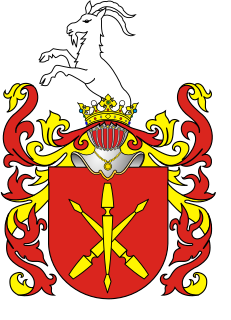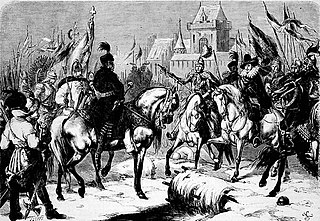
Frédéric François Chopin, born Fryderyk Franciszek Chopin was a Polish composer and virtuoso pianist of the Romantic era who wrote primarily for solo piano. He has maintained worldwide renown as a leading musician of his era, one whose "poetic genius was based on a professional technique that was without equal in his generation."

Zamość is a historical city in southeastern Poland. It is situated in the southern part of Lublin Voivodeship, about 90 km (56 mi) from Lublin, 247 km (153 mi) from Warsaw. In 2014, the population was 65,149.

Jan Sariusz Zamoyski was a Polish nobleman, magnate, and the 1st ordynat of Zamość. He served as the Royal Secretary from 1565, Deputy Chancellor from 1576, Grand Chancellor of the Crown from 1578, and Great Hetman of the Crown from 1581.

Stanisław Wawrzyniec Staszic was a leading figure in the Polish Enlightenment: a Catholic priest, philosopher, geologist, writer, poet, translator and statesman. A physiocrat, monist, pan-Slavist and laissez-fairist, he supported many reforms in Poland. He is particularly remembered for his political writings during the "Great (Four-Year) Sejm" (1788–92) and for his large support towards the Constitution of 3 May 1791, adopted by that Sejm.

Jelita is a Polish coat of arms. It was used by several szlachta families.

Tomasz Zamoyski was a Polish-Lithuanian nobleman (szlachcic) and magnate.

Adam Stefan Zamoyski FSA FRSA FRSL is a British historian and author.

Count Andrzej Hieronim Franciszek Zamoyski was a Polish noble (szlachcic). Knight of the Order of the White Eagle, awarded on 3 August 1758 in Warsaw.

Zamoyski is the name of an important Polish noble (szlachta) family, which used the Jelita coat of arms. It is the Polish term for "de Zamość", the name they originally held as lords of Zamość. The family was influential in Polish politics for several centuries, and its members held various official titles, including those of Count and Countess.

Count Stefan Adam Zamoyski was a Polish nobleman, landowner, and magnate.

Count Stanisław Kostka Zamoyski of Herb Jelita was a Polish nobleman (szlachcic), politician, landowner, and patron of arts.

Count Maurycy Klemens Zamoyski (1871–1939) was a Polish nobleman (szlachcic), politician, social activist, and Minister of Foreign Affairs in the Polish government of the 1920s.

Bernardo Morando, also known as Bernardino or Morandi was an Italian architect from the Republic of Venice. He is notable as the designer of the new town of Zamość, modelled on Renaissance theories of the 'ideal city'.

Samuel Zborowski was a Polish military commander and a notable member of the szlachta. He is best remembered for having been executed by supporters of the Polish king Stefan Batory and chancellor Jan Zamoyski; an event which caused much uproar among the contemporary Polish nobility.

The Battle of Byczyna, also known as the Battle of Pitschen, was the deciding battle of the 1587–1588 War of the Polish Succession, which erupted after two rival candidates were elected to the Polish throne. Both sides had rough parity in forces, with armies about 6,000 strong, divided roughly into half infantry and half cavalry. The battle was an overwhelming victory for the Polish-Swedish faction, led by the Swedish-born king-elect Sigismund III Vasa, over the army of his rival to the throne, Maximilian III, Archduke of Austria.

The Polish–Swedish War (1600–1611) was a continuation of struggle between Sweden and the Polish–Lithuanian Commonwealth over control of Livonia and Estonia, as well as the dispute over the Swedish throne between Charles IX of Sweden and Sigismund III of Poland.

Jan Tomasz Zamoyski was a Polish political activist. He was the 16th and last Ordynat of the Zamoyski Family Fee Tail, senator (1991–1993), president of the National-Democratic Party. Awarded the Order of the White Eagle.

The War of the Polish Succession or the Habsburg-Polish War took place from 1587 to 1588 over the election of the successor to the King of Poland and Grand Duke of Lithuania Stephen Báthory. The war was fought between factions of Sigismund III Vasa and Maximilian III, with Sigismund eventually being crowned King of Poland and Grand Duke of Lithuania. Two major battles of this conflict included the Siege of Kraków, in which Maximilian III failed to capture the capital of the Commonwealth, and the Battle of Byczyna, in which Maximilian was forced to surrender. Sigismund's victory was significantly the doing of Chancellor and Hetman Jan Zamoyski, who stood behind both the political intrigue and the military victories of this conflict.

The Zamoyski Family Fee Tail was one of the first and largest fee tails in the Polish-Lithuanian Commonwealth. It was owned by the Zamoyski family, the richest aristocratic family in Poland. It was established upon the request of Crown Hetman Jan Zamoyski, on 8 July 1589. The fee existed until the end of World War Two, when it was abolished by the communist government of the People's Republic of Poland, which in 1944 initiated an agricultural reform.

Count Andrzej Przemysław Konstanty Jan Władysław Zamoyski was a Polish aristocrat and landowner.















